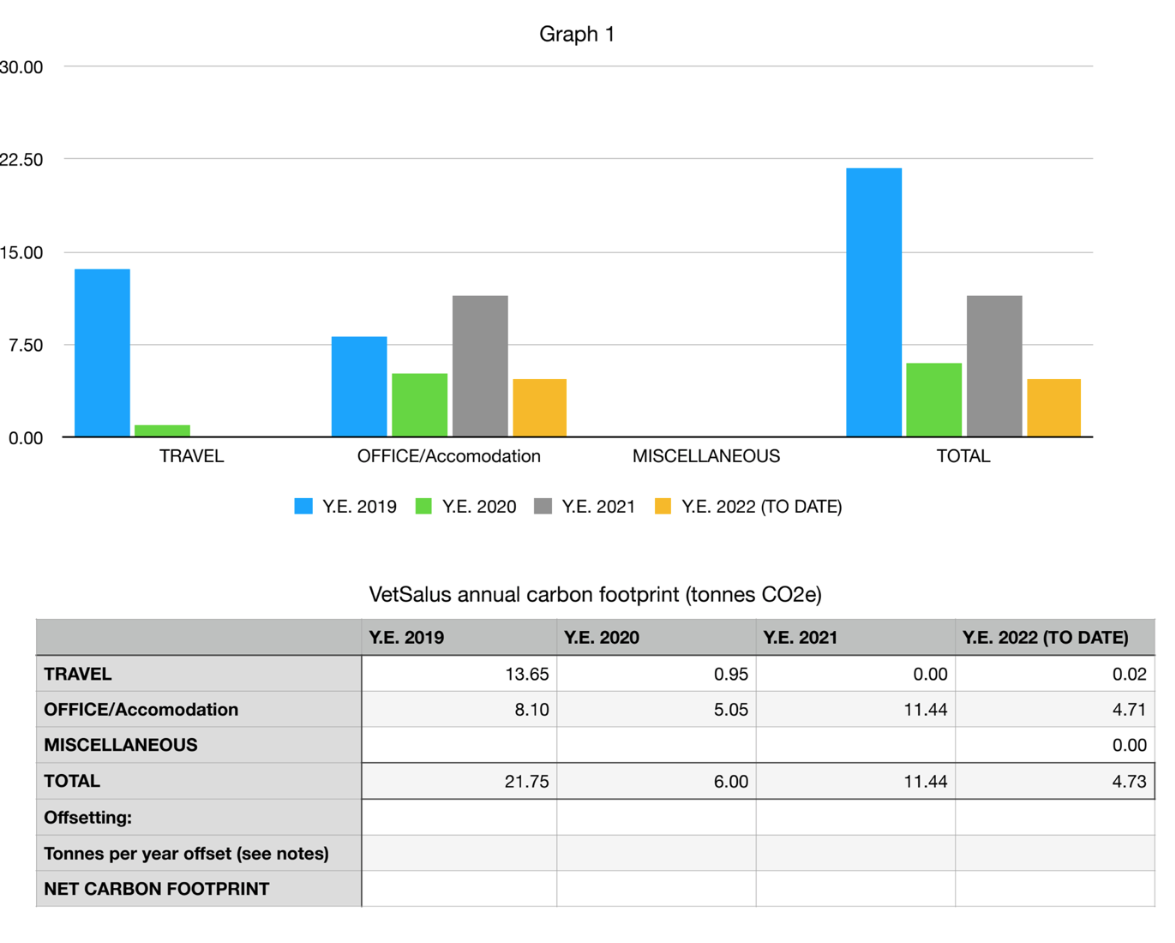Measuring the Carbon Footprint at VetSalus
Introduction:
Since signing up to the SME Climate commitment, ‘Race to Zero’, earlier in the year VetSalus has begun to turn its focus to the carbon footprint generated by the business. As part of the commitment, VetSalus is required to report annually on progress, with the intention of halving our emissions by 2030 and becoming net zero by 2050. As VetSalus is a small organisation, it was assumed that this would be a relatively simple project. It soon became clear that this is not a simple topic. There is a large amount of analysis which could be engaged in, and a wide range of methodologies which might be employed. Numerous online calculators are available and, having experimented with some of these, significant variation in outcomes can be reported. The board required something that would be simple and could be easily updated on a quarterly basis. What follows is a summary of our analysis, together with the provisional results. We hope this is of assistance to others who are tackling similar issues and would value feedback and further debate on this topic. If you would like further information on our system please do not hesitate to contact us.
Setting some initial criteria and policies:
Most of the calculators currently available utilise carbon dioxide equivalents, which attempt to correct for other greenhouse gases, such as methane and nitrous oxide, on the basis of GWP100 (100 year Global Warming Potential). VetSalus is not alone in criticising the use of carbon dioxide equivalents but the alternative, accounting for each greenhouse gas individually, will considerably increase complexity. Thus, somewhat reluctantly, we decided to use CO2 equivalents initially and then look to improve our reporting over time.
Some simple analysis soon arrived at the main contributors to the VetSalus carbon footprint:
- All travel directly related to VetSalus (i.e. specific VetSalus meetings, conferences only) including air travel (travel would be proportionally shared with other businesses, if applicable)
- Overnight accommodation related to these meetings and activities
- Office time, based upon an estimate of the time each office occupant spends working on VetSalus business. Of necessity, this will include:
- “Building attributes” - heat, light etc.
- Computer hardware/mobiles
- Network and data storage costs
- Other (including stationery etc as utilised)
- Miscellaneous - which at this point includes anything else
But fundamentally the system needed to be simple and as several directors were working from home most of the time, individual domestic variables had the potential to quickly added further complications.
Each quarter, all directors and employees of VetSalus will provide the following information:
- Number of hours spent in office on VetSalus work
- Number of kilometres travelled by car for VetSalus business
- Number of kilometres travelled by rail for VetSalus business
- Number of kilometres travelled by air for VetSalus business
- Overnight accommodation (this will be calculated as office hours)
- Any other significant purchases on behalf of VetSalus (with a note on details)
- Any offsets applied on behalf of VetSalus and any changes to office/travel carbon utilisation environment
The board decided to set 2018 as the base year and measure forward from that. It transpired that 2018 included our official launch at World Buiatrics in Japan, so that VetSalus started with a significant international travel footprint.
Results
VetSalus has adopted a ‘fixed value” system which does not at this stage differentiate between individual offices, vehicles and other factors: a fixed conversion factor for office hours and kilometres/miles has been used in all calculations. Research sourced a number of tables which listed average carbon footprints and these have been averaged across all users. e.g. We have applied the factor of 0.2Kg CO2e / kilometre for all travel by motor.

What next?
Having established our baseline position we intend to update our data on a quarterly basis.
These results are certainly not a perfect representation of the VetSalus Carbon footprint and they have been significantly affected by the COVID pandemic; but they represent a starting point. The results also raise a number of important questions:
- By using a fixed value methodology, how can we measure reductions in our carbon utilisation per office hour etc? We intend to review the number used each time we calculate and adjust them based on new information. e.g if one director installs solar panels or travels by electric vehicle, thereby reducing their carbon footprint, we will change the multiplier applied accordingly.
- What about offsetting? At this stage no offsetting has been utilised as we wanted to establish a clear baseline position. In future, individual directors and employees reporting will be questioned as to their policies on offsetting and the board will also discuss purchasing carbon offsets to reduce the overall carbon footprint. VetSalus has committed to the “Race to Zero” and will be working steadfastly to meet its commitments under this campaign.
- Can we produce a simple final figure, incorporating offsetting and improvements in carbon utilisation? We are currently working on a simple summary for office and travel miles which will be updated periodically and monitor changes in utilisation over time. This will provide a summary of carbon footprint ‘efficiency’ which is independent of quantity consumed.
To keep up to date with our work please follow our social media channels, Twitter and LinkedIn, finally make sure you sign up to our newsletter by registering as a user on our website - here.
